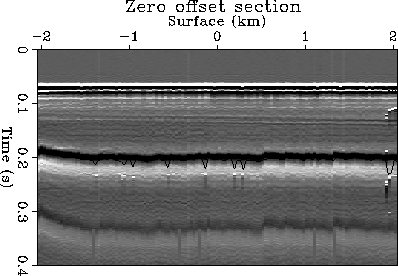




Next: Traveltime picking of the
Up: APPLICATIONS
Previous: APPLICATIONS
Figure ![[*]](http://sepwww.stanford.edu/latex2html/cross_ref_motif.gif) shows a zero-offset section recorded in a marine survey.
Each trace was recorded by a hydrophone below the sea surface, with an air-gun
above it. On the section, the first flat event is the direct arrival of
down-going waves from sources to receivers. The picked traveltimes are
superposed on the event. Because the event is isolated, and noises and
wavelet distortions are small, the curve that indicates the picked traveltimes
follows the event quite well. The second event is the primary reflection
from the sea bottom. The event bends upwards at the left end. The curve
indicating the picked traveltimes is with the event at most locations.
However, at those locations where strong, spiky noises appear,
the algorithm fails to pick the correct traveltimes. The algorithm is
sensitive to spiky noise because adding a large-amplitude spike to a
wavelet considerably changes the phase property of the wavelet.
zospick
shows a zero-offset section recorded in a marine survey.
Each trace was recorded by a hydrophone below the sea surface, with an air-gun
above it. On the section, the first flat event is the direct arrival of
down-going waves from sources to receivers. The picked traveltimes are
superposed on the event. Because the event is isolated, and noises and
wavelet distortions are small, the curve that indicates the picked traveltimes
follows the event quite well. The second event is the primary reflection
from the sea bottom. The event bends upwards at the left end. The curve
indicating the picked traveltimes is with the event at most locations.
However, at those locations where strong, spiky noises appear,
the algorithm fails to pick the correct traveltimes. The algorithm is
sensitive to spiky noise because adding a large-amplitude spike to a
wavelet considerably changes the phase property of the wavelet.
zospick
Figure 5 Picked traveltimes for the direct arrival and the
primary sea bottom reflection. The picks of the primary see bottom reflection
are attracted to large spiky additive noises of unknown origin.










Next: Traveltime picking of the
Up: APPLICATIONS
Previous: APPLICATIONS
Stanford Exploration Project
12/18/1997

![[*]](http://sepwww.stanford.edu/latex2html/cross_ref_motif.gif) shows a zero-offset section recorded in a marine survey.
Each trace was recorded by a hydrophone below the sea surface, with an air-gun
above it. On the section, the first flat event is the direct arrival of
down-going waves from sources to receivers. The picked traveltimes are
superposed on the event. Because the event is isolated, and noises and
wavelet distortions are small, the curve that indicates the picked traveltimes
follows the event quite well. The second event is the primary reflection
from the sea bottom. The event bends upwards at the left end. The curve
indicating the picked traveltimes is with the event at most locations.
However, at those locations where strong, spiky noises appear,
the algorithm fails to pick the correct traveltimes. The algorithm is
sensitive to spiky noise because adding a large-amplitude spike to a
wavelet considerably changes the phase property of the wavelet.
shows a zero-offset section recorded in a marine survey.
Each trace was recorded by a hydrophone below the sea surface, with an air-gun
above it. On the section, the first flat event is the direct arrival of
down-going waves from sources to receivers. The picked traveltimes are
superposed on the event. Because the event is isolated, and noises and
wavelet distortions are small, the curve that indicates the picked traveltimes
follows the event quite well. The second event is the primary reflection
from the sea bottom. The event bends upwards at the left end. The curve
indicating the picked traveltimes is with the event at most locations.
However, at those locations where strong, spiky noises appear,
the algorithm fails to pick the correct traveltimes. The algorithm is
sensitive to spiky noise because adding a large-amplitude spike to a
wavelet considerably changes the phase property of the wavelet.
